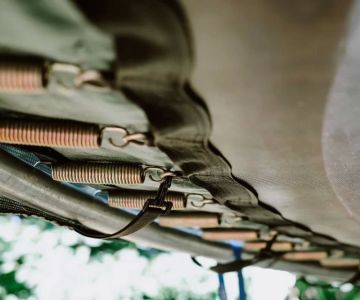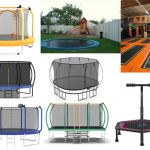- 1-Planning-Your-Indoor-Trampoline-Pit
- 2-Choosing-the-Right-Location-and-Dimensions
- 3-Materials-and-Safety-Considerations
- 4-Step-by-Step-Construction-Process
- 5-Maintenance-and-Enhancing-Your-Trampoline-Pit
1. Planning Your Indoor Trampoline Pit
Building a trampoline pit indoors is an exciting way to create a fun, safe, and year-round recreational space in your home or facility. Before jumping into construction, thorough planning is essential to ensure the pit fits your space, meets safety standards, and suits your intended use.
Start by assessing your goals—whether for personal family fun, training purposes, or entertainment—and establish a budget. This foundation will guide the decisions on size, materials, and design.
1.1 Defining Your Space Requirements
Indoor trampoline pits require adequate ceiling height and floor space to allow safe jumping and aerial maneuvers. A minimum ceiling height of 12 feet is recommended to prevent injuries. Consider nearby walls, furniture, and ventilation to ensure a comfortable environment.
1.2 Regulatory and Safety Standards
Understanding safety guidelines is crucial. Regulations may vary by location but generally cover padding, impact absorption, and structural integrity. Consulting with experts or companies like Trampoline Zone can help you source compliant materials and designs.
2. Choosing the Right Location and Dimensions
Selecting the perfect indoor spot impacts usability and safety. Ideally, choose a room free from sharp edges and obstacles, with easy access and proper lighting.
2.1 Space Layout and Accessibility
A clear, open layout reduces risks of collisions and injuries. Also, consider accessibility for maintenance and potential expansion. If the pit is for commercial use, ensure compliance with local building codes.
2.2 Optimal Dimensions for Safety and Enjoyment
Dimensions vary depending on use but a typical residential pit measures around 10 by 10 feet with a depth of 3 to 4 feet, filled with foam cubes. For professional or training facilities, larger pits provide more versatility.
3. Materials and Safety Considerations
Safety is paramount when building a trampoline pit. The choice of materials directly influences protection against injuries.
3.1 Foam Cubes and Padding
High-quality foam cubes fill the pit to cushion falls and jumps. Use durable, non-toxic foam with sufficient density to absorb impact. Surround the pit with thick padding on edges and trampoline frames to prevent injuries from accidental contact.
3.2 Trampoline Frame and Springs
Opt for sturdy frames made of galvanized steel or similar materials for durability. Springs should be securely attached and covered with protective padding to avoid pinch injuries.
3.3 Floor and Wall Protection
Install shock-absorbing mats on the floor around the pit and soft wall coverings if the pit is close to walls. These measures enhance overall safety and reduce risk during high-energy activities.
4. Step-by-Step Construction Process
Constructing an indoor trampoline pit involves several detailed steps, each vital for a safe and enjoyable result.
4.1 Preparing the Site
Clear the designated area, ensuring a flat, stable surface. Remove any hazards such as protruding nails or debris. Measure and mark boundaries accurately to guide framing.
4.2 Building the Frame and Installing the Trampoline
Assemble the trampoline frame securely according to manufacturer instructions. Check for stability and ensure springs and padding are correctly placed.
4.3 Constructing the Pit and Filling with Foam
Build retaining walls or a pit box to contain foam cubes. The depth should accommodate safe landings. Fill the pit evenly with foam cubes, inspecting for any gaps or unevenness.
4.4 Adding Final Safety Features
Install safety nets or enclosures if needed. Double-check all padding, securing loose parts and verifying compliance with safety standards before use.
5. Maintenance and Enhancing Your Trampoline Pit
Proper maintenance prolongs the lifespan of your trampoline pit and keeps users safe.
5.1 Regular Inspections
Check the condition of foam cubes, padding, and trampoline components frequently. Replace worn or damaged materials promptly to prevent accidents.
5.2 Cleaning and Hygiene
Foam cubes can accumulate dust and allergens. Use foam cleaning solutions and maintain good ventilation to keep the pit fresh and safe.
5.3 Upgrades and Accessories
Consider adding features like angled trampolines, basketball hoops, or interactive lighting to enhance fun and training value. For the best products and advice, visit Trampoline Zone, where you can find quality equipment and expert guidance tailored to your trampoline pit needs.







 Pump It Up Lake Forest Kids Birthday and More4.0 (280 reviews)
Pump It Up Lake Forest Kids Birthday and More4.0 (280 reviews) Urban Air Trampoline and Adventure Park4.0 (349 reviews)
Urban Air Trampoline and Adventure Park4.0 (349 reviews) Church Street Plaza4.0 (731 reviews)
Church Street Plaza4.0 (731 reviews) Fun City Adventure Park3.0 (162 reviews)
Fun City Adventure Park3.0 (162 reviews) Riki Tiki's Indoor PlayGround4.0 (35 reviews)
Riki Tiki's Indoor PlayGround4.0 (35 reviews) Urban Youth Park - South Bay4.0 (107 reviews)
Urban Youth Park - South Bay4.0 (107 reviews) Are Trampoline Parks Safe for Kids? Essential Guide for U.S. Parents
Are Trampoline Parks Safe for Kids? Essential Guide for U.S. Parents How Often Should You Replace Trampoline Springs? Tips for Proper Maintenance
How Often Should You Replace Trampoline Springs? Tips for Proper Maintenance How Much Is a Trampoline? A Detailed Guide to Trampoline Costs and Buying Tips
How Much Is a Trampoline? A Detailed Guide to Trampoline Costs and Buying Tips Bounce Techniques for Stronger Legs: Effective Exercises and Tips
Bounce Techniques for Stronger Legs: Effective Exercises and Tips Essential Music Gear for Trampoline Dance: Complete Guide
Essential Music Gear for Trampoline Dance: Complete Guide Fun STEM Experiments Using Trampolines to Spark Curiosity and Learning
Fun STEM Experiments Using Trampolines to Spark Curiosity and Learning